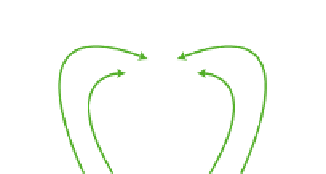Biology Reference
In-Depth Information
(a)
(b)
Scale 100-200 m
40
40
120
No. 4: n = 124
No. 27: n = 84
No. 34: n = 281
100
30
30
PREY
80
20
20
60
AB C D EFG
40
10
10
20
0
0
0
Direction of initial approach
A
B
CDE F
G
A
B
CDE F
G
A
B
CDE F
G
150
30
40
20
No. 39: n = 266
No. 40: n = 83
No. 46: n = 108
No. 49: n = 40
30
100
20
20
10
50
10
10
0
0
0
0
A
B
CDE F
G
A
B
CDE F
G
A
B
CDE F
G
A
B
CDE F
G
Fig. 6.15
Cooperative hunting in lions may involve individual specializations. (a) Seven stalking roles taken by
lionesses towards a prey: A-B positions are 'left wings', C-E are 'centres' and F-G are 'right wings'. (b) Stalking
roles of seven lionesses of the Okondeka pride in Etosha National Park, Namibia. The number of hunts is shown
above each set of histograms. Individuals clearly differed in their positions: for example, number 34 preferred
the 'left wing', numbers 4, 27 and 39 were 'centres', while numbers 46 and 49 preferred the 'right wing'. From
Stander (1992).
Evolution of group living: shoaling
in guppies
The studies described so far in this chapter are based on measurement of short-term
costs and benefits of group living, such as food intake and predation risk. In one study,
it has been possible to show how these costs and benefits translate into evolutionary
change. In 1957, the American ichthtyologist C.P. Haskins moved 200 guppies (
Poecilia
reticulata
) from a predator-rich river system in Trinidad (the Caroni system) to the
almost predator-free headwaters of another river system, the Oropuche. The transferred
fish subsequently colonized the downstream parts of their new river system and again
encountered predators.
In 1989-1991, more than 30 years after the original transfer, Anne Magurran
(Magurran
et al
., 1992) collected guppies from several streams, including the original
predator-rich source from which Haskins took the guppies, the predator-free site
whether they were first introduced and the predator-rich streams they later colonized
from the introduction site. In guppies, shoaling reduces predation (Magurran,
Rapid evolution
of shoaling in
response to
changing
predation



























































































